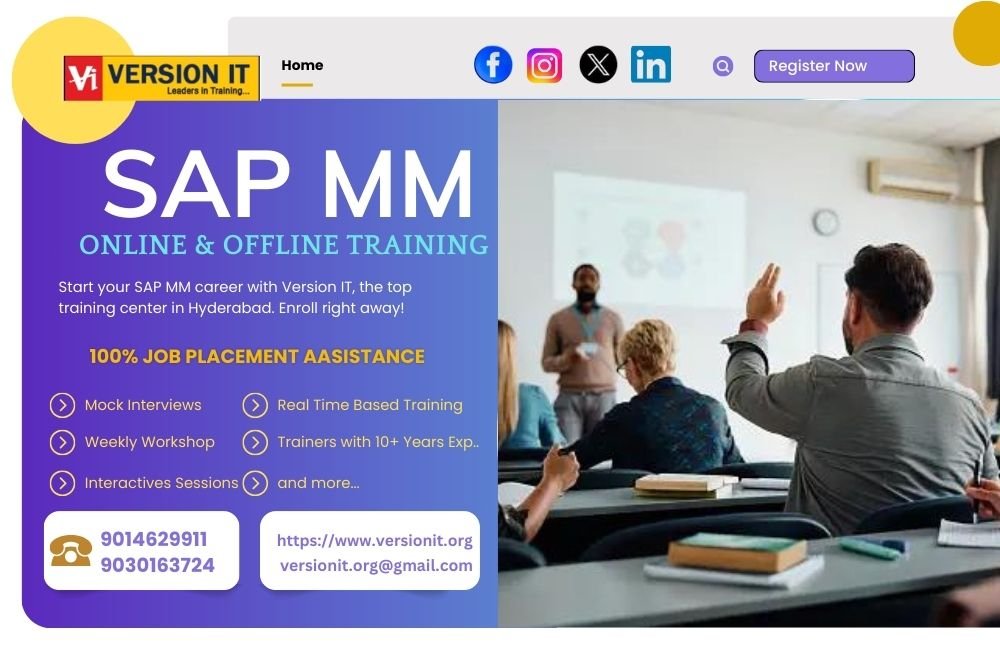Procurement Process in SAP MM: An In-Depth Overview
The procurement process in SAP MM (Materials Management) is one of the most crucial functions of the SAP ERP system. It ensures that materials are acquired from the right suppliers, at the right time, and in the correct quantity and quality. The procurement process in SAP MM is designed to streamline the purchasing activities and optimize inventory management, which directly impacts the overall efficiency of an organization. This process involves various stages, each integrated with different modules in SAP, like SAP FICO for financial accounting, SAP SD for sales, and SAP PP for production.
This article will explain the procurement process in SAP MM, focusing on each phase, the key components, and the overall significance of an efficient procurement system.
Key Stages of the Procurement Process in SAP MM
- Determination of Requirements
- Source Determination
- Vendor Selection and Quotation
- Purchase Order Processing
- Purchase Order Monitoring
- Goods Receipt and Inventory Management
- Invoice Verification
- Payment Processing
- Determination of Requirements
The first step in the procurement process is to identify the materials or services required by the organization. This can be done either manually or automatically through the Materials Requirements Planning (MRP) system in SAP. The requirement can be internal (materials required for production) or external (goods needed for direct consumption, such as office supplies).
- Manual Creation of Purchase Requisition: If the materials are not part of the production plan, a manual purchase requisition is created. This document contains the details of the required material, quantity, and desired delivery date.
- Automatic Requirement Creation via MRP: The MRP system automatically generates purchase requisitions based on inventory levels, production schedules, and sales orders, ensuring that the required materials are ordered at the right time.
- Source Determination
Once the requirement has been identified, the next step is to determine the best source for procuring the material. SAP MM provides tools like source lists and quota arrangements to identify potential vendors.
- Source List: A source list helps in identifying the most suitable vendors for specific materials. It lists approved suppliers along with the agreed delivery terms.
- Quota Arrangement: This is used when a material needs to be procured from multiple vendors. It divides the total requirement between different vendors based on predefined quotas.
- Info Records: SAP MM maintains a record of previous transactions with vendors, known as purchase info records, which provide insights into pricing, delivery times, and terms for future procurement decisions.
- Vendor Selection and Quotation
The next step is to select a vendor. If the source is not predefined, the procurement team may request quotations from different vendors. This step helps the organization evaluate multiple vendors on the basis of pricing, quality, and delivery terms.
- Request for Quotation (RFQ): An RFQ is issued to multiple vendors, inviting them to submit quotes for the requested materials. SAP MM provides functionality to manage RFQs and compare vendor responses.
- Quotation Comparison: Once the vendors respond with their quotes, SAP MM Course enables a comparison based on various criteria like price, delivery time, and vendor reliability. The procurement team selects the best vendor based on the comparison.
- Purchase Order Processing
Once a vendor is selected, the next step is to create a purchase order (PO). The purchase order is a formal document issued to the vendor, specifying the quantity of materials, agreed price, delivery date, and payment terms.
- Types of Purchase Orders: SAP MM supports different types of POs depending on the procurement scenario, such as standard PO (for regular purchases), subcontracting PO (for outsourced production), or consignment PO (for materials held in stock but owned by the vendor).
- Document Flow: SAP MM tracks the entire document flow, starting from the purchase requisition to the purchase order, ensuring complete traceability of the procurement process.
- Purchase Order Monitoring
Once the PO is issued, the organization needs to monitor the progress of the purchase order to ensure that the vendor delivers the materials on time.
- Tracking Delivery: SAP MM enables the tracking of delivery schedules and quantities to ensure timely receipt of goods. If there are delays or discrepancies, the procurement team can take appropriate action, such as expediting the order or contacting the vendor.
- Goods Receipt and Inventory Management
Once the materials arrive, the next step is to perform goods receipt (GR) in the SAP system. The goods receipt process ensures that the materials delivered match the purchase order in terms of quantity and quality.
- Goods Receipt Document: When materials are received, a goods receipt document is created, which updates the inventory levels and triggers the quality inspection process (if applicable).
- Inventory Management: Upon goods receipt, SAP MM updates the stock levels and records the movement of materials within the organization. It integrates with other modules, such as SAP WM (Warehouse Management), to ensure smooth handling and storage of goods.
- Stock Valuation: SAP MM also updates the material valuation records based on the actual cost of the goods received, which impacts financial reporting.
- Invoice Verification
Once the goods are received, the next step is to verify the invoice submitted by the vendor. SAP MM provides tools for three-way matching—matching the purchase order, goods receipt, and vendor invoice to ensure accuracy before payment.
- Three-Way Matching: This process ensures that the details on the vendor’s invoice (quantity, price, etc.) match the information in the PO and the goods receipt.
- Blocking Invoice for Payment: If discrepancies are found during invoice verification (such as overcharging or incorrect quantities), the invoice is blocked for payment until the issues are resolved.
- Payment Processing
The final step in the procurement process is payment to the vendor. Once the invoice is verified, the finance department processes the payment in accordance with the agreed terms.
- Automatic Payment Program (APP): SAP FICO integrates with SAP MM to handle payments automatically. The system schedules payments based on due dates, ensures that cash flow is managed efficiently, and records the payment transaction for future audits.
Importance of the Procurement Process in SAP MM
The procurement process in SAP MM is vital for ensuring efficient operations, cost management, and vendor relationships. Here are some reasons why an efficient procurement process is critical:
- Cost Efficiency: By automating the procurement process, organizations can reduce manual effort, avoid delays, and minimize errors, leading to significant cost savings.
- Supplier Relationship Management: An efficient procurement process ensures timely orders and payments, strengthening relationships with suppliers, which can result in better terms and pricing.
- Inventory Management: A well-managed procurement process ensures optimal inventory levels, preventing overstocking or stockouts, which can disrupt production.
- Compliance and Control: SAP MM ensures that the procurement process adheres to internal policies and external regulations, ensuring transparency and control over purchasing activities.
- Integration with Other SAP Modules: The integration of SAP MM with other modules like SAP FICO, SAP SD, and SAP WM ensures that all processes related to procurement, inventory, and finance are seamlessly connected.
Version IT: The Best Training Institute for SAP MM Training in Hyderabad
Version IT is renowned as the best institute for SAP MM Training in Hyderabad, offering comprehensive training designed to equip students with in-depth knowledge of SAP MM and real-world experience.
- Experienced Trainers: The trainers at Version IT have years of experience in SAP MM, providing students with both theoretical knowledge and practical insights into the procurement process and other SAP MM functions.
- Comprehensive Curriculum: The curriculum covers all aspects of SAP MM, including procurement, inventory management, material valuation, and vendor management, ensuring students are well-prepared for various job roles in the industry.
- Hands-On Training: Version IT emphasizes hands-on learning, offering students the opportunity to work on real-time projects and case studies that reflect actual business scenarios. This practical exposure is critical for mastering SAP MM.
- Flexible Learning Options: Version IT offers both classroom and online training, providing flexibility for students to choose the learning method that best suits their needs.
- Placement Support: The institute provides strong placement assistance, helping students secure roles in leading companies that rely on SAP MM for their operations.
In conclusion, understanding the procurement process in SAP MM is essential for efficient materials management, and Version IT offers the best SAP MM training in Hyderabad to help individuals and professionals excel in their careers.



